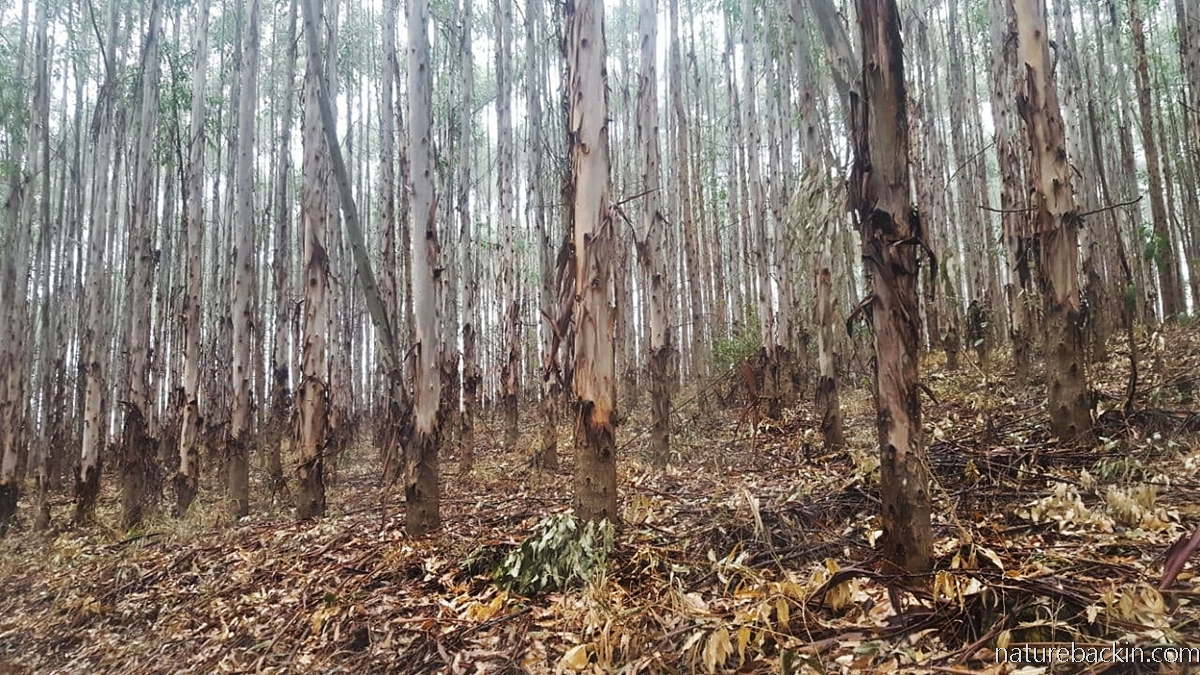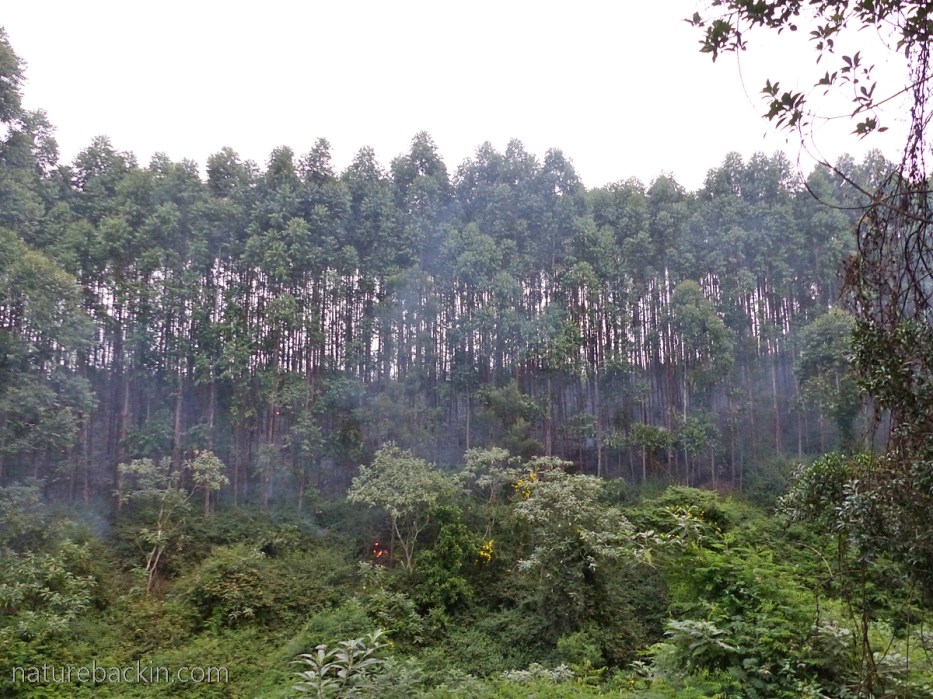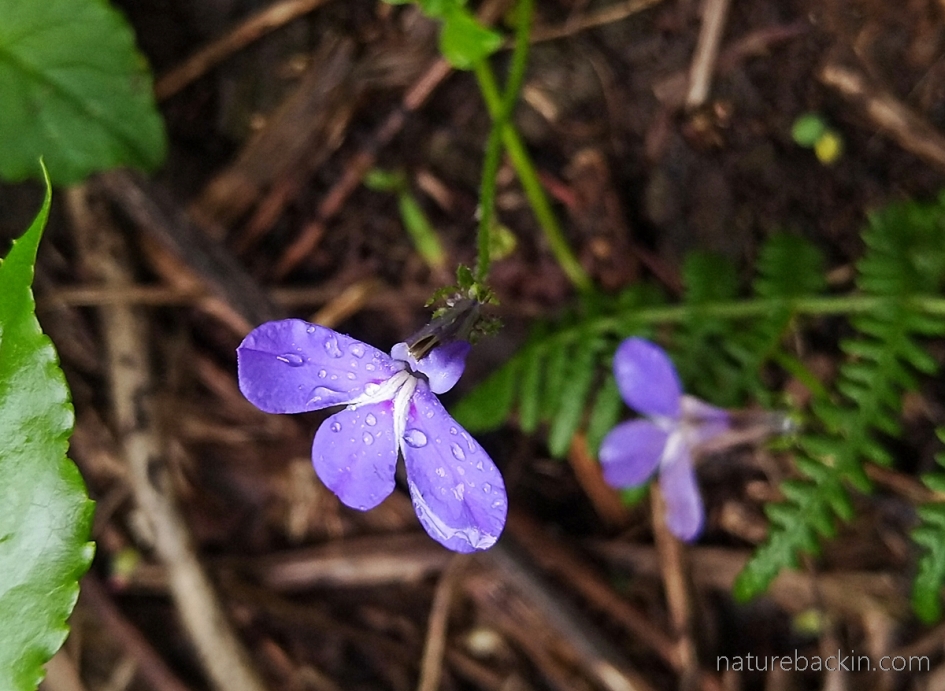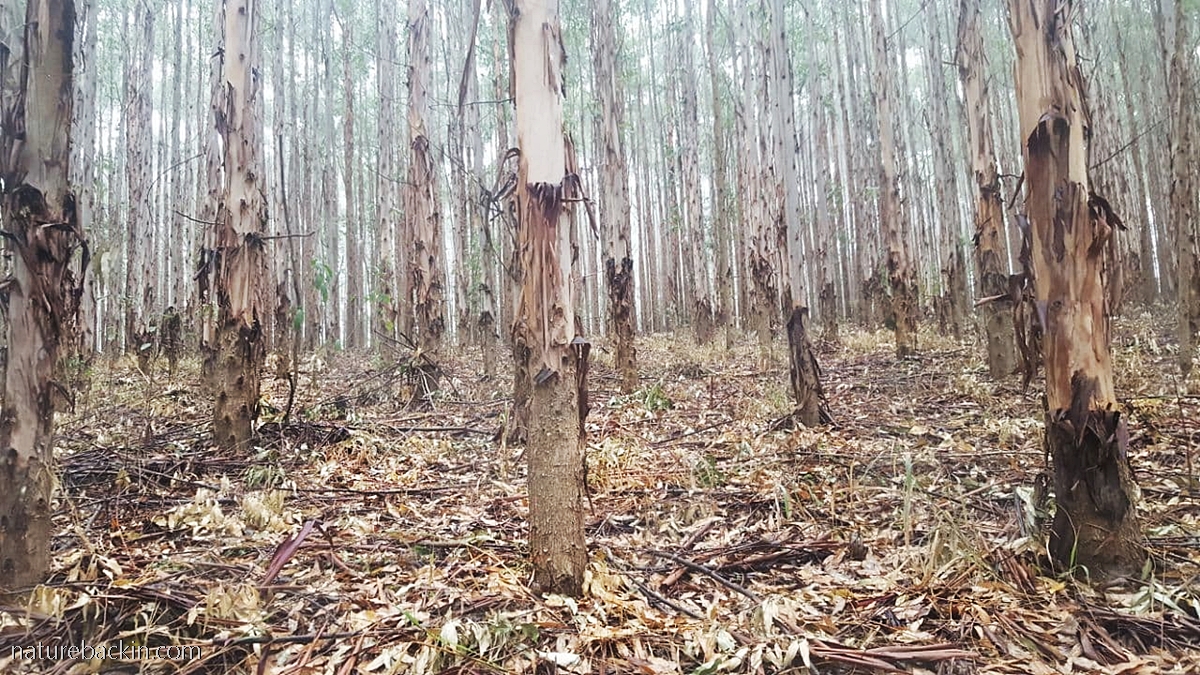Various lockdown permutations since March last year have affected when and where we could walk, but current restrictions allow walking and exercising outdoors so long as protocols are followed. Fortunately for us, we have an easily accessible area for outdoor walking as our suburb is skirted by a commercial plantation.
Of course, a proper woodland with its greater biodiversity would have more appeal, but plantation walking is still a lot more pleasant than walking through suburban streets loud with barking dogs and tense with traffic.

Monoculture anything has a dull uniformity and can border on sterility, but we can try to find a certain charm in its minimalism, as illustrated by the eucalyptus trees photographed in the local plantation on one of our walks with our dogs.
I find I have very few photographs taken on our walks because the plantation does not evoke much interest. The photographs we do have are snapped with our cell phones.
A stream-bed runs through a small valley that forms a marginal space between the plantation and the residential properties on our side of the street. I say stream-bed because this stream is dry and has not flowed for decades, perhaps because the thirsty plantation trees take up so much water.
In the photo below taken of the plantation and its margins behind our house, a small fire can be glimpsed. Fortunately nearby fires in the plantation have all been successfully extinguished by the timber company bringing in water tankers and pumps to hose down and douse the flames.

Flourishing along the margins of the plantation are mostly exotic (alien) species of plants many of which are highly invasive. Visible in the above photo and prominent among the larger species growing in this area are bugweed (Solanum mauritianum), lantana or tickberry (Lantana camera) and Mauritius thorn (Caesalpinia decapetala) all of which compete with indigenous plants and have a negative impact on biodiversity. The first two have poisonous properties and the last two can form impenetrable thorny thickets.

The most recent fire was in September last year and in the above photo a line of fire can be seen snaking through the litter under the trees just before the firefighters arrived to extinguish it. On a walk the next day we paused at an old tree stump that had previously housed a natural hive of wild bees. The stump was still smouldering and as the fire had been fanned in one direction by the prevailing wind, we saw that the stump was located where it appeared the fire had begun. We wondered if someone had been trying to smoke out the bees to get the honey and had started a fire by mistake.

The last time trees in this plantation were harvested was in mid-2010, which is when I took the above photograph. The trees are felled for harvesting every 8 to 12 years. The next round of felling in this part of the plantation commenced a few months ago. Eucalyptus timber is used for making prop shafts in the mining industry, but the bulk of the timber here will be chipped and exported to pulp and paper manufacturers, mostly in Japan.
Prior to the introduction of eucalyptus trees in this area, most of the plantation comprised black wattle (Acacia mearnsii). An extract from the tannin-rich bark can be used in the leather tanning industry. Wattle is still grown commercially but to a lesser extent. The timber can be used for pulp but also to produce charcoal and firewood. Pine is not grown much in this region.

After compartments of trees are felled and the area cleared of timber, the remaining brush is burnt to prevent it from providing fuel for any uncontrolled fires that might start in the future. The plants that generate naturally in the cleared areas are by and large invasive aliens, which of course include prolifically self-seeding trees used in the commercial plantation industry, with the black wattle being a prime example.
Among the self-generated plants visible in the above photo are black wattle, bugweed and lantana. Of course also flourishing are smaller herby alien plants, such as blackjacks (Bidens pilosa) and the like.
This area was formerly grassland, and today commercial plantations cover not only former grasslands but also what used to be discrete patches of indigenous mistbelt forest. Like elsewhere in the KwaZulu-Natal Midlands, in earlier times parts of our suburb accommodated small mixed farms before being taken over several decades ago by expanding residential areas and commercial plantations.

In the plantation, mostly one is hard pressed to find any indigenous plants even at the margins, so I was especially pleased to come across one of the wild lobelias in flower (above). We have also seen a few woodland freesias (Freesia laxa) in flower, and more commonly the Natal Blue Bell (Thunbergia natalensis), which even manages to grow alongside the logging roads. Near muddy patches in the summer we have also seen some wild buttercups, a species of Ranunculus.
It goes without saying that tree plantations that replace grasslands eradicate grassland species, including the birds and mammals that formerly occurred there. With little biodiversity and providing very little food, alien tree plantations impact negatively on former forest dwellers too. An illustration of the unsuitability of fast-growing plantation trees to support many forms of life is their inability to provide nesting opportunities for hole- and cavity-nesting birds in contrast to the diversity of trees in natural woodlands and forests.
Most of the birds that we see occur along the margins of the plantation and in adjacent gardens, and we have no idea what species would occur (or not occur) in more natural plant communities that would have occurred along the now-dry course of the stream.
As far as raptors go, we have noticed a pair of wood owls up in the trees within the plantation, and we once saw a pair of spotted eagle-owls hunkered down on the ground in a small ravine near the dry stream bed. We hear both of these species of owl calling at night.

Old eucalyptus trees on the plantation margins that have escaped being harvested provide potential nesting sites for crowned eagles and black sparrowhawks both of which nest in our area, and possibly also for African harrier-hawks (gymnogenes), which we also commonly see. In the above photo a crowned eagle, perched on bare branches at the top of an old eucalyptus tree, is being subjected to bombardment by a much smaller but plucky fork-tailed drongo. The drongo can be seen flying off before circling around to dive-bomb the eagle again from behind.

There are species of mammals that survive on the margins of the plantation too and these include bushbuck, common duiker, porcupine, genets, very likely rock hyraxes (dassies) and at least three species of mongoose, such as the slender mongoose (above) that I photographed behind our garden. Even caracals have been spotted in parts of the plantation not too far from here.

And of course also living on the margins of the plantation and using the trees on the edge as night-roosting sites is a troop of vervet monkeys that is resident in the area.

Above is a closer view of the eucalyptus trees taken from a path within the plantation. The thick layer of plant debris on the ground results from some of the fierce storms that have occurred recently.

The morning mist makes the plantation look more appealing than usual. We are indeed fortunate to be able to walk in such an environment and in our own neighbourhood too.
I hope that wherever you are, you also have the opportunity to walk in nature. Even when thoroughly domesticated, nature still has the ability to be therapeutically calming and to provide a sense of peace.
Sources:
Malan, Gerard. 2001. The avifauna of riparian-Pinus habitat edges at Mooiplaas forestry estate, KwaZulu-Natal, South Africa. African Journal of Wildlife Research 31(3):73-84. https://www.researchgate.net/publication/287950414_The_avifauna_of_riparian-Pinus_habitat_edges_at_Mooiplaas_forestry_estate_KwaZulu-Natal_South_Africa; South Africa. Department of Transport/KwaZulu-Natal Department of Transport. [n.d.] Forestry KwaZulu-Natal: Freight transport data bank. http://www.kzntransport.gov.za/public_trans/freight_databank/kzn/industries/forestry/index_xml.html; Witt, Harald. [n.d.] The Origins of Commercial Tree Plantations in KwaZulu-Natal. Timberwatch. http://www.timberwatch.org.za/old_site/articles/The%20Origins%20of%20Commercial%20Tree%20Plantations%20in%20KwaZulu-Natal%20.htm
Posted by Carol









March 20, 2021 at 9:44 pm
You’ve absolutely captured great beauty in this place! I love the vertical lines in your shots of the trees.
LikeLiked by 1 person
March 24, 2021 at 5:26 pm
Thanks very much. The mist definitely helped the plantation look much more appealing!
LikeLiked by 1 person
February 8, 2021 at 9:16 pm
You be safe and well also. Always good to read your posts.
LikeLiked by 1 person
February 7, 2021 at 10:23 pm
Your post and photos moved me. Haunting. Sad. Beautiful. I found myself cheering and smiling with each mention of animal and plant life surviving on the fringe. Reminded me of walking the post-volcanic eruption environment of Mount St. Helens. I watched season after season as life returned and recovered slowly to create something beautiful from the ashes. But I know the tree plantations are not an apt comparison. And yes, being able to walk in nature during this pandemic is a source of comfort and calm.
LikeLiked by 1 person
February 8, 2021 at 8:55 pm
Thanks Cheryl. Watching plants reestablishing after the volcanic eruption must have been reassuring.
It seems that for very many people, being in nature whether it is wild or domesticated can be a reassuring solace during these pandemic times. Take care and keep safe.
LikeLiked by 1 person
January 18, 2021 at 1:00 pm
Thank you for this post. I enjoyed your pics of the trees and also revisiting this area. I am always grateful for my view of some lovely large trees where I live. They do seem to be calming and I also enjoy the sounds they make in the wind etc.
LikeLiked by 1 person
January 18, 2021 at 8:35 pm
Thanks Christine. There is something indefinable in the presence of large trees, and I agree that the sounds they make in the wind and so on render them a very dynamic presence.
LikeLike
January 15, 2021 at 4:22 pm
Happy the person who has nature close to home. Most people live in cities. Green cities have a great advantage, especially in these restrictive times. But also because of climate change. I read the forecast for the future is an increase of more than 4 degrees in cities due to. I hope that in the future city planners will have more courage for nature.
Like you I am very happy to have a forest where I can go every day. Hannover has a large city forest that I love very much. Otherwise I would go crazy…
LikeLiked by 1 person
January 15, 2021 at 4:23 pm
Due to climate change… – I was too fast 😊
LikeLike
January 18, 2021 at 8:26 pm
Yes green spaces and especially trees do make cities more live-able, and as you point out green spaces are even more important as temperatures rise due to climate change. That forecast you mention of a 4 degree increase in cities in the future is really frightening.
Enjoy your city forest – I agree that such spaces are essential for one’s sanity.
LikeLiked by 1 person
January 15, 2021 at 3:08 pm
A sobering and meticulously researched article. But there is a ray of hope in the resilience of the indigenous flora and fauna that has survived despite the lack of habitat.
LikeLiked by 1 person
January 18, 2021 at 8:01 pm
Thanks Mariss.
LikeLiked by 1 person
January 15, 2021 at 2:41 pm
Oh dear, you seem to have been making the best of a bad job. We too have far too many sterile, regimentally planted woodlands – pine in our case of course. I keep hoping their moment has passed, but no, they seem to keep coming back. Nevertheless, you have found plenty of interest to share with us on your walk. Thanks.
LikeLiked by 1 person
January 18, 2021 at 8:00 pm
Thanks Margaret – given the many alternatives that we could be living near, making the best of the plantation does provide a good outlet and a peaceful place to walk, so we do count ourselves as fortunate.
I am trying to imagine pine plantations instead of the lovely woodlands and dales that you have featured in your blog.
LikeLiked by 1 person
January 19, 2021 at 9:27 am
We’re very fortunate. None of our woods is large, but they’re all of long standing and lovely little oases.
LikeLiked by 1 person
January 19, 2021 at 8:23 pm
They must be wonderful and provide a sense of connection on several levels.
LikeLiked by 1 person
January 20, 2021 at 8:59 am
I can’t imagine being without them.
LikeLiked by 1 person
January 15, 2021 at 5:16 am
Hi Aunty Carol
I Love your post, I must say, I know, it is barren in comparison to a rich diversity of indigenous fauna and flora, but it is very easy on the eye. Especially with the mist. Hopefully in time IF left alone, it will right itself and bring with it an abundance of biodiversity. Until such a time enjoy it, it could be a shopping mall 🤢🤭
Ps, you are going to have to teach me how to take such good pictures ❤️
LikeLiked by 1 person
January 18, 2021 at 7:55 pm
Thanks Debs. You are so right that the plantation has its benefits, and having once lived across the road from the back end of a shopping centre I know exactly what you mean! For one thing the noise from the refrigerators and air conditioners at night was a constant disturbance.
LikeLike
January 15, 2021 at 4:46 am
Your photos and descriptions echo my thoughts on the eucalyptus plantations here. I haven’t been in them much, in part because they seem so sterile, the lack of birds being my foremost in that. My main interest photographically has been the somewhat spooky uniformity of them, as your photos capture well.
The logs used to be shipped to Japan, but that no longer happens, so now there’s not even any use for the trees. The current plan is to build a biomass power plant and burn the trees, but I’m not convinced that will succeed of even come to pass. Instead, it just leaves me kind of sad thinking what the plantations displaced.
LikeLiked by 1 person
January 18, 2021 at 7:51 pm
You describe so well how I also feel about the eucalyptus plantations. It is sad thinking about what was lost when the plantations took over.
The potential biomass power plant may not be that wonderful either …
LikeLiked by 1 person
January 19, 2021 at 3:17 am
You’re right about the power plant, but the plan still splutters along. We’ll see.
LikeLiked by 1 person
January 19, 2021 at 8:21 pm
I will be interested to know in time how it goes.
LikeLiked by 1 person
January 20, 2021 at 4:30 am
I’ll let you know.
LikeLike
January 15, 2021 at 2:37 am
Dear Carol, Yes, walking through our adjacent pine plantations in the early months of lockdown last year was a sanity saver, so I can fully identify. And yes, even in these places, almost barren of indigenous flora and fauna, there are still wonderful organisms to be found. Thank you for seeing the beauty and sharing it. xxx
LikeLiked by 1 person
January 15, 2021 at 8:41 pm
Thanks Christeen – I am glad to hear that you could also find some benefit from the pine plantations. Plantations can feel so barren and yet they do have their own vitality, at least until they get cut down, and even then it can be interesting to see what manages to survive in the space that has been so suddenly and dramatically altered, Take care xxx
LikeLiked by 1 person
January 14, 2021 at 9:47 pm
Your photos of the trees in straight rows shrouded in mist are geometrically appealing. As you write, some forest is better than no forest, but I bet you pine for a fully diversified forest. Invasive species are becoming more rampant here as well. It takes a lot of effort to keep them in control, a Sisyphean task to be sure.
LikeLiked by 1 person
January 15, 2021 at 8:37 pm
A proper natural forest is so completely different to a plantation, but it still does have a strength and vitality. It is remarkable how much wind the plantation ‘soaks up’ and it protects us from strong wind storms. Without an army of people it is almost impossible to control the many invasive species that grow on the margins of the plantation. We nurture a patch of indigenous trees that have been planted on the margin behind where we live, but there is what feels like a constant onslaught from rampant and smothering alien vegetation that scrambles and climbs, even to great heights up the tall trees. I think we have to accept that these plants are here to stay, and find ways of limiting them and reintroducing indigenous species so that they can survive alongside all these alien plants.
LikeLike
January 15, 2021 at 9:37 pm
Doug Tallamy (an advocate of planting natives) oversaw a study which concluded that if the number of non-natives does not exceed 20-22%, the ecosystem can continue to thrive. Above that, insect species and up the food chain are impacted negatively. It’s a good target to shoot for, as many gardeners here like their Asian natives… I have a couple Japanese maples that I love. But these days, I try to make better choices by selecting natives.
LikeLiked by 1 person
January 18, 2021 at 8:32 pm
Thanks Eliza. that percentage of non-natives as a maximum is interesting as a guideline, including for suburban gardeners.
Sadly though our commercial plantations are 100% alien plants, and even at the margins I would guess that over 90% of the vegetation comprises alien (non-native) plants most of which are highly invasive, at least where we are.
LikeLike
January 18, 2021 at 9:30 pm
Is that scale local or regional? Would you say that has resulted in ecosystem disruption and/or collapse?
LikeLiked by 1 person
January 19, 2021 at 8:21 pm
That is a big question, so I will just say that grasslands form the most threatened biome in South Africa as a whole. An article on grassland birds (2012) notes that “65% of South Africa’s grasslands have been irreversibly transformed, and only 2.8% are formally conserved – mostly in the Drakensberg” https://www.wwf.org.za/?unewsid=6322.
In a 2010 article, titled ‘Plantation Forestry in South Africa and its Impact on Biodiversity’, (by Armstrong, A.J. et al. Southern African Forestry Journal, September 2010) referring to the Midlands area of KwaZulu-Natal (where I live) it notes the Natal Mistbelt is at least 92% transformed and that afforestation has had a marked impact on biodiversity resulting in extinctions or near-extinctions of plant and animal species. The Natal Mistbelt as a whole is 41% under commercial tree farming, and is consequently fragmented, causing isolation of populations with some remnant populations below minimum viable size, with several species reduced to Red Data status. This article although 10 years old provides a useful overview – see https://www.researchgate.net/publication/261587751_Plantation_Forestry_in_South_Africa_and_its_Impact_on_Biodiversity/link/57877dff08ae95560407a5fe/download
LikeLike
January 19, 2021 at 10:25 pm
Heartbreaking stats, for sure. And worse when you think of it occuring globally. Scary really. 😦
Thanks for the links.
LikeLiked by 1 person
January 21, 2021 at 8:20 pm
It is heartbreaking and scary – as you say such scenarios are occurring across the globe.
LikeLiked by 1 person
January 14, 2021 at 8:56 pm
Oh I so love reading your posts. From New Zealand they keep me close to the KZN I know and love from my trips to visit my parents. I have just purchased the book “The Hidden Life of Trees” by Peter Wohlleben and am looking forward to learning more from his insights into forests and ecosystems. Thank you for all the wonderful information and photographs
LikeLiked by 1 person
January 15, 2021 at 8:27 pm
Thank you and its nice to know my blog provides you with a connection to KZN, especially now when travel is not possible. Thank you for the mention of the Wohlleben book – his insights sound fascinating. I will be seeking out the book.
LikeLike
January 14, 2021 at 8:05 pm
I agree a plantation is better than nothing. Trees are very important for us, I think, for there is something calming and ‘solid’ about them. This is one reason why I value the enormous Natal fig that dominates one section of our garden. It provides a sort of spiritual outlet, especially during this prolonged period of one or other confinement. Your photographs conjure an appealing look enhanced by your emphasis on the positive impact of being able to walk among trees.
LikeLiked by 1 person
January 15, 2021 at 8:25 pm
I really like what you say about trees and their importance to us – it can be difficult to explain what it is about them that can have such a profound effect on us and even that this can have spiritual dimension as you describe. Thanks for this comment as it makes me aware that even though I love trees perhaps I do unwittingly in many ways take them too much for granted.
LikeLiked by 1 person